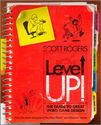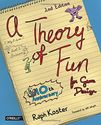-
About
- About Listly
- Community & Support
- Howto
- Chrome Extension
- Bookmarklet
- WordPress Plugin
- Listly Premium
- Privacy
- Terms
- DMCA Copyright
- © 2010-2025 Boomy Labs
 Aryadi Perwira Subagio
Aryadi Perwira Subagio
Listly by Aryadi Perwira Subagio
Here are references for people who want to learn more about game design

Note: This article was originally published in issue #2 of Interactive Fantasy, and also appears on the author's website. by Greg Costikyan There's a lotta different kinds of games out there. A helluva lot. Cart-based, computer, CD-ROM, network, arcade, PBM, PBEM, mass-market adult, wargames, card games, tabletop RPGs, LARPs, freeforms. And, hell, don't forget paintball, virtual reality, sports, and the horses.
Welcome to a book written to challenge you, improve your brainstorming abilities, and sharpen your game design skills! Challenges for Game Designers: Non-Digital Exercises for Video Game Designers is filled with enjoyable, interesting, and challenging exercises to help you become a better video game designer, whether you are a professional or aspire to be. Each chapter covers a different topic important to game designers, and was taken from actual industry experience. After a brief overview of the topic, there are five challenges that each take less than two hours and allow you to apply the material, explore the topic, and expand your knowledge in that area. Each chapter also includes 10 "non-digital shorts" to further hone your skills. None of the challenges in the book require any programming or a computer, but many of the topics feature challenges that can be made into fully functioning games. The book is useful for professional designers, aspiring designers, and instructors who teach game design courses, and the challenges are great for both practice and homework assignments. The book can be worked through chapter by chapter, or you can skip around and do only the challenges that interest you. As with anything else, making great games takes practice and Challenges for Game Designers provides you with a collection of fun, thoughtprovoking, and of course, challenging activities that will help you hone vital skills and become the best game designer you can be.

Game Design [Bob Bates] on Amazon.com. FREE shipping on qualifying offers. Game Design, Second Edition offers a behind-the-scenes look at how a game gets designed and developed-from the day the idea is born to the day the box hits the shelves.

Level Up!: The Guide to Great Video Game Design [Scott Rogers] on Amazon.com. FREE shipping on qualifying offers. Design and build cutting-edge video games with help from video game expert Scott Rogers! If you want to design and build cutting-edge video games but aren’t sure where to start

Now in full color, the 10th anniversary edition of this classic book takes you deep into the influences that underlie modern video games, and examines the elements they share with traditional games such as checkers. At the heart of his exploration, veteran game designer Raph Koster takes a close look at the concept of fun and why it’s the most vital element in any game.
Why do some games become boring quickly, while others remain fun for years? How do games serve as fundamental and powerful learning tools? Whether you’re a game developer, dedicated gamer, or curious observer, this illustrated, fully updated edition helps you understand what drives this major cultural force, and inspires you to take it further.
You’ll discover that:
Games play into our innate ability to seek patterns and solve puzzles
Most successful games are built upon the same elements
Slightly more females than males now play games
Many games still teach primitive survival skills
Fictional dressing for modern games is more developed than the conceptual elements
Truly creative designers seldom use other games for inspiration
Games are beginning to evolve beyond their prehistoric origins

"Game Feel" exposes "feel" as a hidden language in game design that no one has fully articulated yet. The language could be compared to the building blocks of music (time signatures, chord progressions, verse) - no matter the instruments, style or time period - these building blocks come into play. Feel and sensation are similar building blocks where game design is concerned. They create the meta-sensation of involvement with a game.
The understanding of how game designers create feel, and affect feel are only partially understood by most in the field and tends to be overlooked as a method or course of study, yet a game's feel is central to a game's success. This book brings the subject of feel to light by consolidating existing theories into a cohesive book.
The book covers topics like the role of sound, ancillary indicators, the importance of metaphor, how people perceive things, and a brief history of feel in games.
The associated web site contains a playset with ready-made tools to design feel in games, six key components to creating virtual sensation. There's a play palette too, so the desiger can first experience the importance of that component by altering variables and feeling the results. The playset allows the reader to experience each of the sensations described in the book, and then allows them to apply them to their own projects. Creating game feel without having to program, essentially. The final version of the playset will have enough flexibility that the reader will be able to use it as a companion to the exercises in the book, working through each one to create the feel described.
